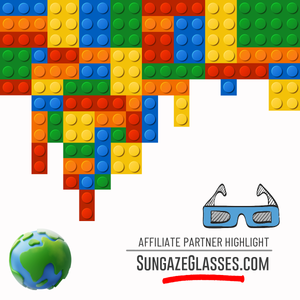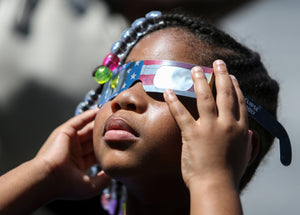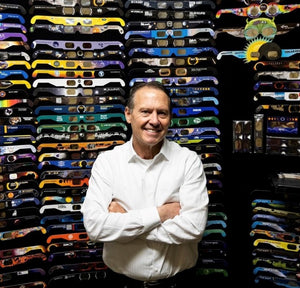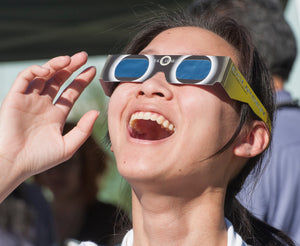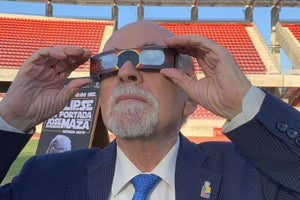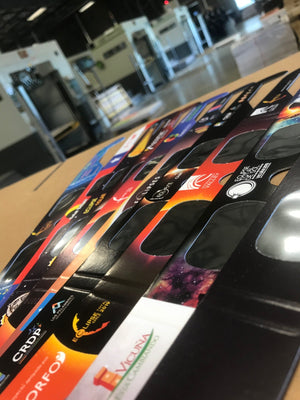Where the Heck Did All Those $2 Paper Eclipse Glasses Come From? Meet the Guy Who Made 40 Million, Just in Time

On August 21, John Jerit will not be kissing his sister.
August 21, of course, is the date of the solar eclipse, which will cut a swath from Oregon to South Carolina. Those not positioned to see the event at 100 percent might as well be smooching their sibling, according to Jerit, founder and CEO of American Paper Optics, located just outside of Memphis. But in the Memphis area, the view is just 94 percent, so Jerit plans to motor three hours to Nashville to enjoy the full lunar Monty. "If you get to Nashville it will be like experiencing a night of passion with the person that you most want to be with in your life," says Jerit. "It will be an 'Oh my God' screaming and crying and cussing moment."
For Jerit, awe of the natural is mixed with gratitude for the commercial. American Paper Optics is the nation's largest maker of paper 3-D glasses: more than 2 billion pairs incorporated into magazines, kids' meals, theme park rides, and Blu-ray movies.
The company also specializes in eclipse glasses that protect viewers' eyes from ultraviolet radiation. The first total eclipse visible across the nation since 1918 will roughly double the company's 2017 revenues, from $7 million to almost $14 million. Unlike most of American Paper Optics' products, which are given away in promotions or packaged with DVDs and toys, the eclipse glasses are being sold in stores and online, for $2 a pop.
American Paper Optics has been making glasses in the Memphis area--the business is based in the city of Bartlett--since 1991. At Jerit's factory the work force has swelled from around 40 to 70 in the two-and-a-half years that American Paper Optics has been preparing for E-Day.
Jerit expects to sell more than 40 million eclipse glasses, which incorporate a filter that reduces sunlight to safe levels. He has made glasses emblazoned with the names of companies, schools, and charities, as well as glasses attached to aliens' heads, astronaut helmets, and cowboy hats.
Over 25 years, David Burder has sold tens of millions of American Paper Optics products through his company, 3D Images, England's oldest supplier of all things 3D to the commercial marketplace. "They have never missed a deadline, despite some ridiculously short lead times," says Burder. "They are always on the lookout for novel technology and have invested heavily in buying exclusive licenses."
Fireworks and burgers
John Jerit grew up around spectacle. His father designed theaters: everything from high-school auditoriums to performance arts centers. As a kid in Memphis, Jerit often saw shows in spaces created by his dad. Even back then, "I had a little carny in me," he says.
That trait helped Jerit land a job selling sparklers and rockets by the side of the road for the American Fireworks Company. He started the summer before college and worked his way up to vice president. In 1987, a small holographic business sent his boss and mentor, Dale Wilson, a pair of paper glasses with diffraction lenses that create a rainbow effect at light shows. The business thought American Fireworks could market them to consumers playing with sparklers in their backyards.
Wilson wasn't interested. But Jerit, who fished the glasses out of the garbage, was. He bought a batch of paper diffraction glasses and sold 7,000 pairs in four hours at a fireworks show in Memphis. Over the next year, Jerit made periodic trips to peddle glasses around the country.
From science to slashers
The glasses cost Jerit 25 cents apiece; he priced them at a buck. Making them, he knew, would be cheaper. So he teamed again with Wilson to buy equipment, and they started manufacturing out of the fireworks plant. In 1990, Jerit bought out Wilson and moved American Paper Optics to a small shop in Memphis.
The company's first nine months were brink-of-death rocky. Then came a call from an astronomer. A total eclipse was projected for July 11, 1991. The astronomer had created a protective filter for vulnerable retinas. Could American Paper Optics glue the filters into frames for sale in Hawaii and South and Central America, where the eclipse would be visible?
Why sure, said Jerit. Also: Can we pay you a royalty to make and sell eclipse glasses ourselves? American Paper Optics produced several hundred thousand glasses for the astronomer. It sold a million to Corona Beer, for distribution to eclipse partiers in Mexico. "That sale gave me the capital to stay alive," says Jerit. "And it showed me what was possible."
The next big order arrived six months later: 6 million glasses for New Line Cinema, for viewing a 3-D sequence in one of the Nightmare on Elm Street sequels. With business growing, in 1996 Jerit built his own manufacturing space. The move came just in time for American Paper Optics' biggest job yet. The Mexican entertainment giant Televisa planned to broadcast 3-D versions of the erotic Emmanuelle films. Twenty million pairs would satisfy the naughty demand.
There goes the sun
Soon 3-D was blowing up. And American Paper Optics was everywhere. It made glasses for the Sports Illustrated swimsuit issue, the Discovery Channel's 3-D Shark Week, and even a Super Bowl commercial. If you bought a 3-D DVD or Blu-ray movie, chances are American Paper Optics glasses came with the case.

But slowly the buzz grew less buzzy. Revenues, which peaked at $20 million in 2010, dropped more than half.
Then, in 2015, Jerit learned the eclipse was coming, and would be viewable in the U.S. At once he created an eclipse-dedicated website and started designing new frames. He commissioned a retired NASA astrophysicist to write a book on the subject. (Walmart is stocking a quarter million copies.) He hired a PR firm.
Jerit doesn't expect sales to stay at this level after August 21. But he hopes to retain some momentum. The company is already backed up on orders for glasses designed to view Christmas lights. Telescope makers have learned about the business, offering a new market for promotional products.
"It is nice to have this pop, but this is a great business, whether it is $7 million or $20 million," says Jerit. And there's hope: The next total solar eclipse in the United States is just seven years away. "We are already thinking about 2024," he says.
- Jason Lewin
